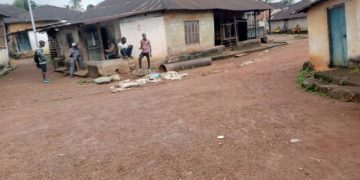By Kemo Cham
The Executive Director of the National Public Health Agency (NPHA) of Sierra Leone, Prof. Foday Sahr, has said that ongoing investigation of a suspected case of Viral Hemorrhagic Fever (VHF) is a normal routine in their line of work.
The country’s top public health protector addressed the media in a press conference on Monday, two days after news of the death of a health worker sparked fears of outbreak of a viral hemorrhagic fever disease.
The deceased, identified as a 29-year old female health worker, fell ill while working in a public health facility in the eastern Kono District, according to authorities.
Initial report shared on social media suggested that she displayed VHF symptoms, but Prof. Sahr said the only symptoms she exhibited were common to diseases they deal with on a daily basis.
“Cases of suspected viral hemorrhagic fever diseases we get every week in our updates. This particular case is nothing unusual from what has been happening,” he said at the presser held at the Emergency Operations Center at Cockrill in the west end of Freetown.
An important symptom of VHFs is bleeding, and the deceased didn’t show that, noted Prof. Sahr.
News about the death of the health worker broke over the weekend and soon went viral, amid fears that it could be Ebola, prompting a press statement from the NPHA saying that it had deployed a team of surveillance officers in Kono immediately after receiving the report.
On Sunday, NPHA released a second statement, revealing that test results from samples from the deceased were indeterminate, which means that they are inconclusive.
An official from the Central Public Health Laboratory explained that this was due to the chemical, formalin, used to preserve the remains of the deceased at the funeral home.
“Because of the presence of formalin, we were unable to adequately confirm that there is a presence of VHF. So we don’t know whether it is positive or negative,” explained Doris Harding, head of the Central Public Health Lab located at Lakkah.
She said the samples were tested for all eight different VHFs that are part of reportable diseases in Sierra Leone.
As of Monday, 2 December, a total of 303 people the deceased interacted with between Kono and Freetown have been identified and subjected to monitoring and observation, public health authorities said, noting that these are the only means left to determine whether the case was VHF or not.
“Because there was no viable sample from the corpse, the only reasonable thing to do is to continue observing these contacts if they would come down with any symptoms. And at the end of the 21 days, which we are not supposed to do, all high risk contacts would be re-tested,” the NPHA boss said.
Already, some of the contacts have gone a maximum of 19 days as at Monday, 2nd December without symptoms. And the highest incubation period for VHF diseases is 21 days.
Harold Thomas, Risk Communication Lead at the NPHA, told ManoReporters that every contact will have to undergo the full 21-day observation and monitoring period and then the agency will wait for an additional 21-day period before declaring the emergency over.
“We have activated all necessary response protocols to mitigate any potential risk, Thomas stressed during the press conference.
According to Prof. Sahr, the issue has drawn international attention, including Sierra Leone’s neighour Liberia, which he said had heightened its surveillance in response to the situation.






















